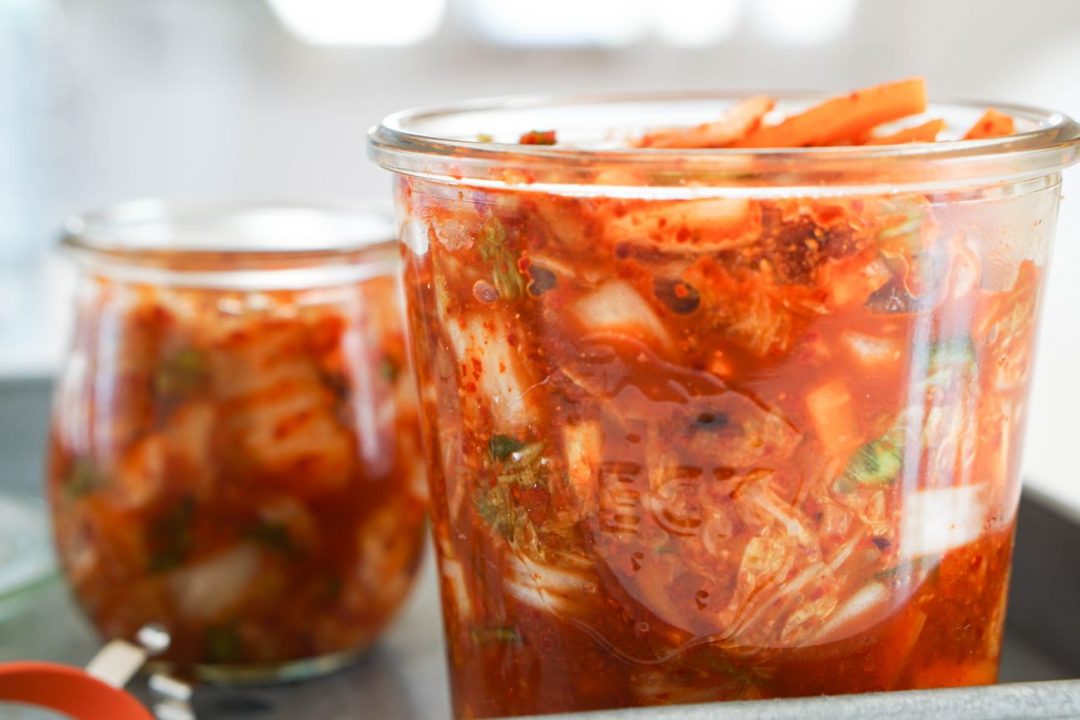
Kimchi
Kimchi, a staple in Korean cuisine, is a vibrant and tantalizing fermented dish celebrated for its complex flavors and numerous health benefits.
Ingredients
- 1 medium sized head of Napa cabbage
- 1/4 cup kosher or sea salt (iodine free)
- Water
- 1 teaspoon peeled grated ginger
- 5 or 6 garlic cloves grated
- 1 teaspoon sugar
- 2 tablespoons salted shrimp paste or 3 tablespoons of water
- 1 or more tablespoons Korean red pepper flakes depends on how hot you like it
- 4 scallions trimmed then cut into 1/2 to 1 inch pieces
- 8 ounces Daikon radish peeled then cut into matchstick like pieces
Instructions
- Cut the Napa cabbage lengthwise, Remove the cores from each piece. Next, cut quarter crosswise into about 2 inch wide strips.
- Put the cabbage in a large bowl and sprinkle with salt. Using gloved hands, rub the salt into the cabbage until it begins to soften a little.
- Cover cabbage with enough water and place a plate on top. Next put something heavy on top to weigh it down with something heavy. Let stand for 2 hours.
- Rinse the cabbage under cold water 2 to 3 3 times and drain for about 15 minutes.
- Clean the bowl you were using and add the ginger, garlic, sugar, and fish sauce, or water. Stir until smooth.
- Stir in the red pepper flakes, (1 tablespoon for mild, 4 to 5 for spicy, Set aside.
- When cabbage is ready, gently squeeze out the water and add it to the spice paste.
- Add the scallions and Daikon radish.
- Using your gloved hands, gently mix the spice paste into the vegetables until thoroughly coated.
- Put the Kimchi into a 1 quart sized jar, pressing down until the brine rises up, covering the vegetables, leaving 1 inch of space at the top. Close the jar.
- Ferment on the kitchen counter at a cool room temperature for 4 days out of direct sunlight. Put a plate or bowel underneath just it case it overflows.
- Check the Kimchi every day, pressing down on the vegetables occasionally with a spoon to keep them submerged in the brine. This also helps release gases produced during the fermentation process.
- Taste test occasionally until you feel it's ripe enough,
- When ready, put the jar in the refrigerator. You can eat it immediately but it will taste best after 1 to 2 weeks.
Notes
The versatility of kimchi allows it to shine in numerous culinary contexts: it can be savored as a fiery side dish, adding a punch of flavor to a simple bowl of steamed rice or used to enhance the richness of stews and soups like the comforting kimchi jjigae. It's also perfect as a zesty topping for burgers or tacos, offering a crunchy, flavorful twist. Whether you're a lover of bold, spicy tastes or seeking to elevate your meals with a probiotic-rich ingredient, kimchi's unique flavor profile and adaptability make it an exquisite addition to a wide array of dishes, promising to transform the ordinary into the extraordinary.
Tried this recipe?Mention @LivingWellRecipes or tag ##LivingWellRecipes!

Leave A Comment